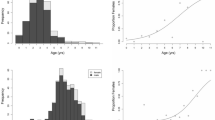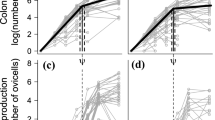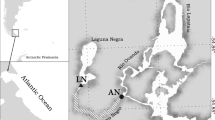Abstract
There is growing evidence across taxa for a mortality-growth rate tradeoff, however the extent to which individuals experience selection both for and against growing faster in the wild can be difficult to assess. We used otoliths to assess growth rates in the wild for Xiphophorus multilineatus, a species of swordtail fish with genetically influenced male alternative reproductive tactics. The ARTs are thought to be maintained due to a trade-off between a higher probability of reaching sexual maturity (smaller sneaker males) and maturing later as a large male with higher mating success (larger courter males). We show that the early juvenile growth rates of the subadult courter males were faster as compared to the other juveniles, potentially suggesting selection for growing faster to increase the probability of reaching sexual maturity. However, variance in the early juvenile growth rates of adult courter males was reduced (truncating high values) as compared to the subadult courter males and overall growth rates were faster in the subadult courter males than the adult courter males. These results support a cost of growing faster as juveniles: reduced longevity as an adult. We also detected a negative relationship between the early growth rates of females and their age, further supporting a longevity cost to growing faster. While both male ARTs are likely to experience stabilizing selection on growth rates, the differences between the morphs in how they optimize this tradeoff in relation to overall fitness (courters optimize growing faster to increase probability of reaching sexual maturity, sneakers optimize longevity as adults) has the potential to lead to disruptive selection between the ARTs on growth rates. We show that the data collected here is consistent with the “growth-mortality optimization” hypothesis and highlight some of the challenges that stabilizing selection presents for examining adaptive variation of growth rates in a natural environment.






Similar content being viewed by others
References
Acre MR, Alejandrez C, East J, Massure WA, Miyazono S, Pease JE, Grabowski TB (2017) Comparison of the precision of age estimates generated from fin rays, scales, and otoliths of Blue Sucker. Southeast Nat 16:215–224
Arendt J (1997) Adaptive intrinsic growth rates: an integration across taxa. Q Rev Biol 72(2):149–177
Barson NJ et al (2015) Sex-dependent dominance at a single locus maintains variation in age at maturity in salmon. Nature 528:405–408
Biro PA, Abrahams MV, Post JR, Parkinson EA (2004) Predators select against high growth rates and risk-taking behavior in domestic trout populations. Proc R Soc Lond B 271:2233–2237
Bono LM, Rios-Cardenas O, Morris MR (2011) Alternative life histories in Xiphophorus multilineatus: evidence for different ages at sexual maturity and growth responses in the wild. J Fish Biol 78:1311–1322
Brothers EB, Mathews CP, Lasker R (1976) Daily growth increments in otoliths from larval and adult fishes. Fish Bull 74(1):1–8
Campana S, Neilson J (1985) Microstructure of fish otoliths. Can J Fish Aquat Sci 42:1014–1032
Criscuolo F, Monaghan P, Nasir L, Metcalfe NB (2008) Early nutrition and phenotypic development: ‘catch-up’ growth leads to elevated metabolic rate in adulthood. Proc R Soc Lond B Biol Sci 275:1565–1570
de la Mata R, Hood S, Sala A (2017) Insect outbreak shifts the direction of selection from fast to slow growth rates in the long-lived conifer Pinus ponderosa. Proc Natl Acad Sci 114:7391–7396
Douhard F, Gaillard JM, Pellerin M, Jacob L, Lemaitre JF (2017) The cost of growing large: costs of post-weaning growth on body mass senescence in a wild mammal. Oikos 126:1329–1338
Francis R, Campana SE (2004) Inferring age from otolith measurements: a review and a new approach. Can J Fish Aquat Sci 61:1269–1284
Grafen A (1988) On the use of data on lifetime reproductive success. In: Clutton-Brock TH (ed) Reproductive success. University of Chicago Press, Chicago, pp 454–471
Houde ED (1989) Comparative growth, mortality, and energetics of marine fish larvae: temperature and implied latitudinal effects. Fish Bull 87:471–495
IBM SPSS Statistics for Macintosh, Version 22.0
Jones CM (1992) Development and application of the otolith increment technique. In: Stevenson DK, Campana SE (eds) Otolith microstructure examination and analysis. Canadian special publication of fisheries and aquatic sciences. Springer, New York, pp 1–11
Kallman KD (1989) Genetic control of size at maturity in Xiphophorus. In: Meffe GK, Snelson FF (eds) Ecology and evolution of livebearing fishes (Poeciliidae). Prentice Hall, Englewood Cliffs, pp 163–184
Lampert KP et al (2010) Determination of onset of sexual maturation and mating behavior by melanocortin receptor 4 polymorphisms. Curr Biol 20:1729–1734
Lee WS, Monaghan P, Metcalfe NB (2013) Experimental demonstration of the growth rate—lifespan trade-off. Proc R Soc B 280:20122370
Liotta MN, Abbott JK, Rios-Cardenas O, Morris MR (2019). Tactical dimorphism: the interplay between body shape and mating behavior in the swordtail Xiphophorus multilineatus (Cyprinodontiformes: Poeciliidae). Biol J Linn Soc. https://doi.org/10.1093/biolinnean/blz053
Mangel M, Stamps J (2001) Trade-offs between growth and mortality and the maintenance of individual variation in growth. Evol Ecol Res 3:583–593
Meister H, Esperk T, Välimäki P, Tammaru T (2017) Evaluating the role and measures of juvenile growth rate: latitudinal variation in insect life histories. Oikos 126:1726–1737
Metcalfe NB, Monaghan P (2001) Compensation for a bad start: grow now, pay later? Trends Ecol Evol 16:254–260
Metcalfe NB, Monaghan P (2003) Growth versus lifespan: perspectives from evolutionary ecology. Exp Gerontol 38:935–994
Morris MR, Ryan MJ (1990) Age at sexual maturity of male Xiphophorus nigrensis in nature. Copeia 1990:747–751
Morris MR, Brewer J, Rios-Cardenas O (2010) Variation in mating preference within a wild population influences the mating success of alternative mating strategies. Anim Behav 79:673–678
Morris MR, Rios-Cardenas O, Lyons S, Tudor MS, Bono L (2012) Fluctuating asymmetry indicates optimization of growth rate over developmental stability. Funct Ecol 26:23–731
Morris MR, Friebertshauser RJ, Rios-Cardenas O, Liotta MN, Abbott JK (2016) The potential for disruptive selection on growth rates across genetically influenced alternative reproductive tactics. Evol Ecol 30:519–533
Nava E, Villar EI, Clemente MC, Rey J, García A, Fernández-Peralta L, Otero P (2018) Digital imaging tool to enhance otolith microstructure for estimating age in days in juvenile and adult fish. IEEE J Ocean Eng 43:48–55
R Core Team (2017) R: A language and environment for statistical computing. R Foundation for Statistical Computing, Vienna, Austria. https://www.R-project.org/. Accessed 07 May 2019.
Rauchenberger M, Kallman KD, Morizot DC (1990) Monophyly and geography of the Rio Panuco basin swordtails (Genus Xiphophorus) with descriptions of four new species. Am Museum Novit 2975:1–41
Rios-Cardenas O, Bono L, Morris MR (2018) Negative frequency-dependent selection and fluctuations around an equilibrium for alternative reproductive tactics in the swordtail Xiphophorus multilineatus. Anim Behav 140:19–28
Roussel JM, Haro A, Cunjak RA (2000) Field test of a new method for tracking small fishes in shallow rivers using passive integrated transponder (PIT) technology. Can J Fish Aquat Sci 57:1326–1329
Schneider CA, Rasband WS, Eliceiri KW (2012) NIH image to imageJ: 25 years of image analysis. Nat Methods 9:671–675
The GIMP Team (1997–2014) GIMP 2.8.10. www.gimp.org
Acknowledgements
We thank Lisa Bono for advice on assessing the otoliths, and Neil Metcalfe for comments on a previous version of the manuscript. This research was supported by a STINT grant from Sweden (Grant No. IG2012-5089) (PI Jessica K. Abbott), PURF grant from Ohio University (Grant No. 2017-2018) (to M. Luke Weinstein) and a PACE grant (Grant No. MM6185116) (to Molly R. Morris). Oscar Rios-Cardenas was supported by a Sabbatical scholarship from the CONACYT during the writing of this paper. Fish were collected in Mexico under the permit Pesca de Fomento No. DGOPA 23857.031215.12071, and all work was approved by the Ohio University Animal Care and Ethics committee (IACUC 12-L-042).
Author information
Authors and Affiliations
Corresponding author
Ethics declarations
Conflict of interest
The authors declare no conflicts of interest.
Additional information
Publisher's Note
Springer Nature remains neutral with regard to jurisdictional claims in published maps and institutional affiliations.
Rights and permissions
About this article
Cite this article
Weinstein, M., Liotta, M.N., Solitt, A. et al. Selection on growth rates via a trade-off between survival to sexual maturity and longevity in the swordtail fish Xiphophorus multilineatus. Evol Ecol 33, 549–566 (2019). https://doi.org/10.1007/s10682-019-09989-w
Received:
Accepted:
Published:
Issue Date:
DOI: https://doi.org/10.1007/s10682-019-09989-w




